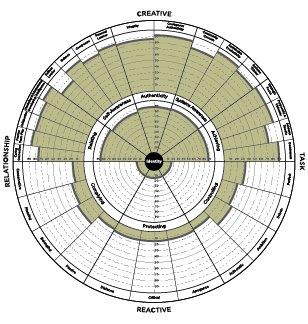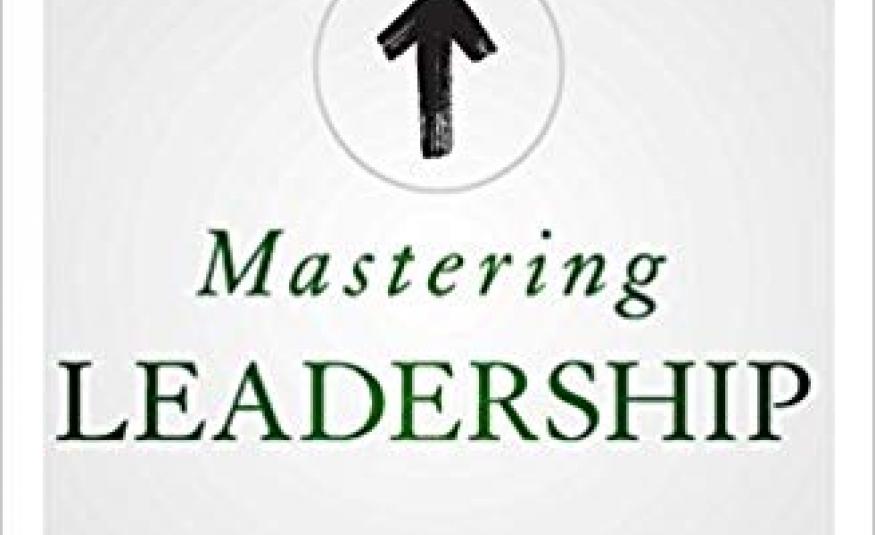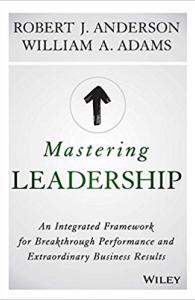In their book Mastering Leadership, R.J.Anderson and W.A. Adams describe in the Leadership Circle Profile (LCP) [see Figure 1] how successful leadership leads to success in the organization. The authors compared the leadership results of more than 500,000 surveys with the organization results of the companies of the respondents. Their conclusion? Within the best 10% of the organizations, managers scored 80% on the LCP. On the other hand, the managers at 10% of the least performing companies scored only 30% in the same framework.
This article describes (naturally) how the LCP is structured, and how you can grow as a leader to get closer to the benchmark of 80% leadership score.

Figure 1: Leadership Circle Profile of the effective leader
SOURCE: https://leadershipcircle.com/
The LEADERSHIP CIRCLE PROFILE is a spider diagram in which we see the results of 29 features on which a leader can be classified. In Figure 1 above, we see the "ideal" score of an effective leader. High scores on the top half, and low scores on the bottom half. This is because the upper half describes behaviour that further helps you to be effective, and the lower half the behaviour generally obstructs effectiveness.
What is not shown in this model is self-centred leadership. This type of leadership should not really be called leadership, because the person is not yet able to look beyond the interests of him or herself. On average, we are all self-centred up to and around our 18th birthday, and as we mature, most of us grow to the next level of leadership, which would be reactive leadership. According to the authors, around 5% of adults do not make the move to reactive leadership and continue to focus on themselves. These people can be very good at their job but are not candidates for leading a team.
In the lower half of the LCP in Figure 1 we see 3 themes of reactive leadership. These are tendencies that get in the way of ourselves to be most effective, but that get something done. Managers who are strong in controlling, protecting and following rules score high in the bottom part. These three categories are further subdivided into a total of 11 traits, including conservative thinking, autocratic acting, being critical and being ambitious. The authors describe that 75% of managers perform strongly in this half of the model. The good news is that reactive leadership is sufficient to achieve objectives and to have a department perform as expected. But it does not lead to exceptional results as in the 10% best performing organizations.
The upper half of the diagram describes creative leadership skills (also referred to as creative competencies). This half describes the effectiveness of 5 categories, based on research from other leadership thinkers, including the thinkers Senge, Block, Kouzes and Posner, and Maxwell described on this blog. Among others authenticity, self-awareness and being able to relate to others come back in these categories. These 5 categories are further subdivided into 18 features, such as integrity, balance, selflessness and system thinking. According to the authors, about 20% of managers in an average organization move in this half of model. In a top 10 performing organization, 80% of managers move here.
One of the reasons why the difference between the average organization and the top performing organizations is so big is that a management team is only as strong as the weakest link. That is why having a strong team is so important and one of the most important tasks of a manager is to continuously check whether everyone is in the right place, or as Jim Collins writes: the right people are on the bus.
The authors describe 6 WAYS OF LIFE OF A CREATIVE LEADER that you can practice daily to further develop your creative leadership.
Live from your discerning purpose. Living from creativity means that you have an idea of what your role in life / society / organization is and how you can contribute to that. From this almost spiritual belief of being able to make a contribution, being able to make a difference, you gain much more strength than just trying to do what is in your job description.
Be a visionary. When you have found your "discerning purpose", you can convey a personal vision of where you see that the organization needs to change. The more specific the vision is (measurable results for example) the easier it is for other people to relate to your vision. The best visions are collective, which means that several people can link their personal goals to the organizational vision.
Reflect on your own doubts and fears. Only if you are willing to think and be honest with yourself about your strengths, weaknesses, fears and doubts, you can consciously make a plan of how to deal with it.
Have crucial conversations (the authors describe this as courageous conversations). Have the courage to always speak the truth and to put difficult themes on the table rather than ignore that they are in the way of your collective vision. From your authentic self, not from the authoritarian self (see also the summary of the book Crucial Conversations by Patterson).
Develop your intuition. Of course, we prefer to make decisions based on data. But what if complete data is not always available? Creative leaders dare to make decisions based on their gut feeling when necessary. When we do this, we should keep the collective goal in mind, not only our self-interest.
Practice system thinking. Always try to use the full system when you solve a problem, instead of dealing with a symptom (see the summary of the fifth discipline from Senge on this topic).
Mastering Leadership is a great book about leadership. As an integral model, Anderson and Adams are the first to have developed one model in which proven leadership theories of other thinkers come together. The results of the organizations and the profiles of the managers in these organizations show that it is important to learn to show creative leadership and this book shows how.
continue to:
The First 90 Days - M.Watkins (summary)
BRON





